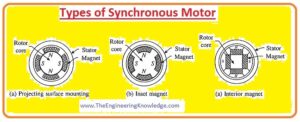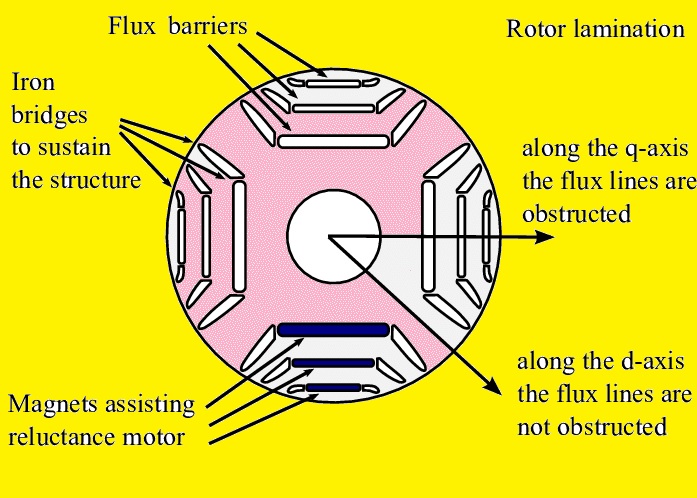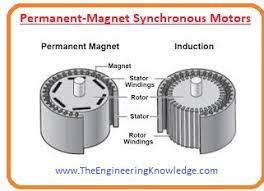 Hello friends, I hope all of you are fine. In today’s tutorial, we are gonna have a look at Types of Synchronous Motor. In the electrical system there are 2 main types of mostly used motors first one is synchronous motor and second one is induction motor. The main difference in these 2 motors is that the induction motor is self-starting while synchronous motor is not self-starting, it needs special arrangements for starting its working. In our power system, the most used motor is synchronous motor as it can operate at lagging, leading and unity power factor.
Hello friends, I hope all of you are fine. In today’s tutorial, we are gonna have a look at Types of Synchronous Motor. In the electrical system there are 2 main types of mostly used motors first one is synchronous motor and second one is induction motor. The main difference in these 2 motors is that the induction motor is self-starting while synchronous motor is not self-starting, it needs special arrangements for starting its working. In our power system, the most used motor is synchronous motor as it can operate at lagging, leading and unity power factor.
In today’s post, we will have a look at its different types, their working, applications, and circuits. So let’s get started with Types of Synchronous Motor.
Types of Synchronous Motor
- There are 2 main categories of synchronous motors first one is non- excited and the second one is DC excited motors.
- These categories of motors are defined according to magnetization behavior of the synchronous motor.
Let’s discuss these categories with detailed and their subcategories.
Non-Excited Synchronous Motors
- The rotor of these motors is constructed by steel. During its rotation at synchronous speed, it follows the synchronous rotating field in different steps, due to this it provides constant field.
- Due to field interaction of stator with a rotor, it becomes electromagnet and it has north and south poles that interact with stator field poles in this way rotor moves.
- The rotor is made from such that has high value for magnetization and demagnetization mean its retentively is high.
- These non-excited motors are further divided into three main types that are described here.
- Reluctance motors
- Hysteresis motors
- Permanent-magnet motors
- Let’s discuss these motors with detailed.
Reluctance Synchronous Motors
- The rotor of these motors is constructed by the steel that has different poles like salient rotor motors.
- Characteristically there are rarer rotor than stator poles to lessen torque ripple (it is a factor that occurs in numerous electrical motors structure, causes to increment and decrement in output torque as shat of rotor revolves) and to stop the poles from such alignment that cannot produce torque.
- The magnitude of the air-gap in the magnetic circuitry and reluctance is lowest when the poles are in a straight line with the revolving field of stator, and upsurges with the angle among them.
- This makes a torque dragging the rotor into placement with the nearby pole of the stator rotating field.
- So at synchronous speed rotor is locked up with the revolving field of the static part of motor.
- It cannot initiate operation of motor due to these poles of rotor are wound with the squirrel cage windings inserted in them, to deliver torque lower synchronous speed.
- The motors initiate as an induction motor until it gets synchronous speed when the rotor gets locked with the rotating field of rotor.
- The rating of these motor is started from few HP to almost twenty-two kilowatts.
- Less rating reluctance motor has less value of torque and mostly used in different instrumentation submissions.
- Reasonable torque, higher rating motors use squirrel cage structure with jagged rotors.
- When these motor cast-off in a variable frequency power supply, all motors in the scheme can be regulated at a similar speed.
- The frequency of the supply defines the rotating speed of the motor.
Hysteresis Synchronous Motors
- The rotor of this motor is constructed by high coercive steel in a cylindrical shape. Coercive material is such that have a high value of magnetization and then a larger value demagnetization field in the opposite direction.
- due the field of stator that is revolving produces a voltage in the rotor and field in opposite direction.
- Due to hysteresis (it is the energy required to magnetize and demagnetize any material) the angle of the magnetization lags the field provided at stator.
- The consequence of this is that the axis of field produced at the rotor lags the field at stator and angle, creating a torque as the rotor attempts to follow the revolving speed of rotor.
- As the speed of rotor is less than speed of stator field that known as synchronous speed every element of the rotor bears a retrogressive field at a frequency that energies it around its hysteresis loop that makes rotor field to lagging and generate torque.
- At rotor, there is two poles less reluctance bar construction. As the rotor tries to reach the rotating filed of a stator and slip become 0, this magnetizes and in line stator’s field, make rotor locked with the field of stator.
- A main benefit of the hysteresis motor is that as the lag angle do not depend on speed, it produces an initial point to get synchronous speed.
- Due to this feature, it is self-starting motor so there is no need of special circuit for starting though numerous schemes have a squirrel-cage winding arrangement fixed in the rotor to deliver additional torque at the starting of motor.
Permanent-Magnet Synchronous Motors
- The rotor of this motor consists of permanent magnet assembled with the steel that provides continues field without any interruption.
- At the stator alternating current supply is connected to produce rotating field.
- When the rotor rotates at synchronous speed its permanent magnet locked up with a rotating field of stator.
- These motors are alike to the brushless direct current motors.
- As the rotor is permanent magnetic so it provides constant field due to this induction windings cannot be connected with these motor for starting.
- Instead, these motors need such a source that has a variable frequency.
DC-Excited Synchronous Motors
- The rating of this motor is larger than one HP or one KW. The external direct current source is connected with the rotor of these motor for excitation.
- This direct current source is connected with motor by slip ring by rectifier circuit for rectification of supply.
- The direct current at rotor can be provided by 2 ways first one is by connecting an external source and second is by attaching direct current generator with the shaft of the rotor.
so friends these are the types of synchronous motors that are described in this tutorial. If you still have any query please ask in comments. See you in the next tutorial.
- I also have written some related articles you can also read them are listed here.I
- Introduction to Synchronous Motor
- Synchronous Motor Torque-Speed Characteristic Curve
- Synchronous Motor Starting Method
- What is Synchronous Condenser (Capacitor)
- Synchronous Motor Power Correction.
- Types of Synchronous Motor
- Effect of Field Current Changes on a Synchronous Motor.











well written and good work…
V goood
Excellent information to note. Thanks very much for the information.
thanks for appreciation
Hello! I’m at work browsing your blog from my new iphone! Just wanted to say I love reading your blog and look forward to all your posts! Keep up the excellent work!